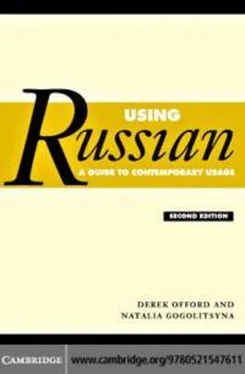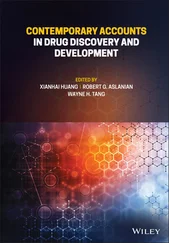Derek Offord - Using Russian - A Guide to Contemporary Usage
Здесь есть возможность читать онлайн «Derek Offord - Using Russian - A Guide to Contemporary Usage» весь текст электронной книги совершенно бесплатно (целиком полную версию без сокращений). В некоторых случаях можно слушать аудио, скачать через торрент в формате fb2 и присутствует краткое содержание. Год выпуска: 2005, Издательство: Cambridge, Жанр: Языкознание, на английском языке. Описание произведения, (предисловие) а так же отзывы посетителей доступны на портале библиотеки ЛибКат.
- Название:Using Russian : A Guide to Contemporary Usage
- Автор:
- Издательство:Cambridge
- Жанр:
- Год:2005
- ISBN:нет данных
- Рейтинг книги:4 / 5. Голосов: 1
-
Избранное:Добавить в избранное
- Отзывы:
-
Ваша оценка:
- 80
- 1
- 2
- 3
- 4
- 5
Using Russian : A Guide to Contemporary Usage: краткое содержание, описание и аннотация
Предлагаем к чтению аннотацию, описание, краткое содержание или предисловие (зависит от того, что написал сам автор книги «Using Russian : A Guide to Contemporary Usage»). Если вы не нашли необходимую информацию о книге — напишите в комментариях, мы постараемся отыскать её.
Using Russian : A Guide to Contemporary Usage — читать онлайн бесплатно полную книгу (весь текст) целиком
Ниже представлен текст книги, разбитый по страницам. Система сохранения места последней прочитанной страницы, позволяет с удобством читать онлайн бесплатно книгу «Using Russian : A Guide to Contemporary Usage», без необходимости каждый раз заново искать на чём Вы остановились. Поставьте закладку, и сможете в любой момент перейти на страницу, на которой закончили чтение.
Интервал:
Закладка:
of formality).
The last two types of variation are particularly important for us here, since no individual speaker of a language, whatever region or class he or she emanates from and irrespective of whether he or she writes and speaks what is considered the standard form of the language, uses the language in the same way in all situations. People make linguistic
choices, which are determined by the situation in which they find
themselves, selecting certain lexical, morphological and syntactic forms from among the options available in their language. They may even
vary their pronunciation (and in Russian, their stress) according to the context. It is important for advanced learners of a language to be aware of this variety in the language’s use, both in order that they may be sensitive to the nuances of what they hear and read and in order that they themselves may use language that is appropriate in a given
situation and has the desired impact. After all, a sophisticated
expression used in the wrong context may sound laughably pompous,
while a coarse turn of phrase addressed to the wrong company may
cause offence.
Bearing in mind what has been said about variety, one needs when
studying language to reflect on the following factors. Who is using the language in a given instance, and with what intent? What form of
communication is being used? What is its subject-matter? And what is the context? In other words, one should consider the user, purpose,
medium, field and situation.
Factors relating to the speaker himself or herself which help to
determine the type of language he or she uses are the speaker’s age, 7
1
Varieties of language and register
sex, place of origin (see 1.5), level of education and social position or status. These factors may impinge on language directly, by affecting a person’s accent, way of addressing others, range of vocabulary and
command of grammar, and indirectly, by shaping and delimiting a
person’s knowledge and experience.
The purpose of communication in a given instance also has a bearing
on the form of language used. One may be using language merely to
impart information, as is the case for example in a scholarly article or lecture, a textbook or a weather forecast; or to persuade, as is the case in an editorial article, a lawyer’s speech in court or a political broadcast; or merely for social intercourse, as is the case in a conversation with friends. Language used for the first purpose is likely to be logical, coherent, matter-of-fact, relatively sophisticated syntactically and shorn of emotional expressiveness. Language used for the last purpose, on the other hand, is likely to be less rational and less complex syntactically, and may deploy a range of emotional and expressive resources.
The medium used for communication also significantly affects the
language used. Perhaps the most important distinction to be made
under this heading is the distinction between spoken and written
forms of language. The distinction has been defined by David Crystal in the following way. Speech is time-bound and transient. The speaker has particular addressees in mind. Because of the probable lack of
forethought and the speed of delivery the constructions used are
relatively simple and loose. There is a higher incidence of coordinating conjunctions than subordinating conjunctions. Spoken language may
incorporate slang, nonsense words and obscenity. Utterances may be
repeated or rephrased and comments interpolated. It is prone to error, but there is an opportunity for the speaker to reformulate what has
been said. Such factors as loudness, intonation, tempo, rhythm and
pause play an important role. In the event of face-to-face
communication extra-linguistic aids to communication might be used,
such as expression, gesture and posture. Speech is suited to social
intercourse, the expression of personal feelings, opinions and attitudes.
Writing, on the other hand, is space-bound and permanent. The
writer is separated from the person addressed, that is to say the reader.
The written language tends to be carefully organised and its syntax
relatively intricate. There is a higher incidence of subordination in it than there is in speech. Documents may be edited and corrected
before they are disseminated and format and graphic conventions may
strengthen their impact. Writing is suited to the recording of facts and the exposition of ideas. It should be noted, though, that there is no simple correlation between speech and informality, on the one hand,
and writing and formality on the other. While the written language
tends to be more formal than the spoken language it is not necessarily so. For example, the written language in the form of a letter to a
partner, friend or relation is likely to be less formal than such examples of the spoken language as an academic lecture, a radio or television interview, or a political speech.
8
1.3
Registers
As for field, language is affected by subject-matter in an obvious
way, inasmuch as fields of activity and branches of knowledge have
their special terminology, for example, political, philosophical,
scientific, medical, musical, literary, sporting, professional and so forth.
However, the effect of field on language may go further than
terminology. Groups have distinctive ways of expressing themselves:
doctors, for example, are likely to describe patients’ symptoms in
language altogether different from that used by patients themselves.
Finally, regarding situation, one’s mode of expression may be affected by the nature of the relationship that exists between the user and the person or people with whom he or she is communicating. Language is
likely to vary according to such factors as whether one is speaking, for example, to one’s elders (with any one of a range of nuances from
respect, deference, sympathy or affection to condescension or
intolerance), to children (lovingly, reproachfully, sternly), to a superior or junior at work, or to an intimate or a stranger.
1.3
Registers
The varieties of language that result from the interaction of the factors described in 1.2 represent stylistic levels which, in common with authors of other books in this series, we shall term registers. 3 Although the number of registers that may be identified is quite large, for the purposes of this book a scale will be used on which three main
registers are marked (low, neutral and high). These registers will be referred to throughout the book as R1, R2 and R3, respectively.
Beyond the first of these registers lie demotic speech (1.3.2) and vulgar language (5.6) and within R3 lie various functional styles (функционa´льныe сти´ли) which will be classified here as scientific or academic style, official, legal or business style, and the styles of journalism and political debate (1.3.4).
These registers, which are examined in more detail below, broadly
speaking reflect a spectrum ranging from informality, in the case of R1, to formality, in the case of R3. Insofar as this spectrum reveals a view of language as low (сни´жeнный), neutral (нeйтрa´льный) or high (высо´кий), it may be traced back in Russia to the work of the poet, scientist and student of language Lomon ósov, who in his Прeдuсло´вue о nо´льзe кнuг цeрко´вных в росси´йском языкe´ ( Preface on the Use of Church Books in the Russian Language , 1758) famously defined three linguistic styles (ни´зкий, посрe´дствeнный, высо´кий) and laid down the genres in which it seemed appropriate to use each of them. To a
Читать дальшеИнтервал:
Закладка:
Похожие книги на «Using Russian : A Guide to Contemporary Usage»
Представляем Вашему вниманию похожие книги на «Using Russian : A Guide to Contemporary Usage» списком для выбора. Мы отобрали схожую по названию и смыслу литературу в надежде предоставить читателям больше вариантов отыскать новые, интересные, ещё непрочитанные произведения.
Обсуждение, отзывы о книге «Using Russian : A Guide to Contemporary Usage» и просто собственные мнения читателей. Оставьте ваши комментарии, напишите, что Вы думаете о произведении, его смысле или главных героях. Укажите что конкретно понравилось, а что нет, и почему Вы так считаете.












